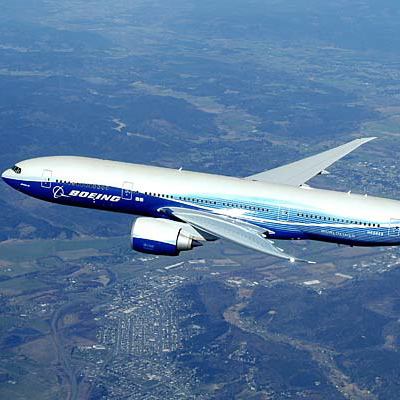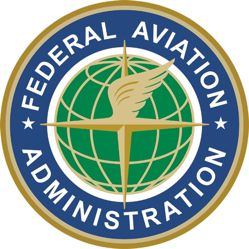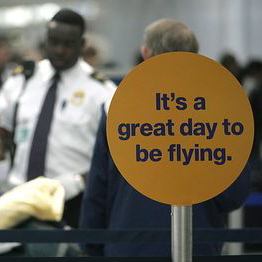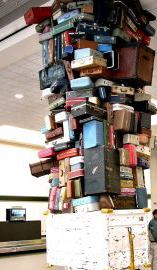Travel Tips
Travel Detective Blog: Too Fat to Travel, Airplane Safety, and Stolen Luggage
 What a week for news in travel. People are getting thrown off the plane for just about anything. Just ask Kevin Smith.
What a week for news in travel. People are getting thrown off the plane for just about anything. Just ask Kevin Smith.
Have you sat in a Southwest seat lately? We’re all too fat to fit.
But he got thrown off and now it’s going to be an interesting challenge to see what the definition of “fat” is, because the FAA doesn’t have one.
It’s left up to individual airlines and individual airlines have different seat widths.
 And then there was a situation on Spirit Airlines. I have to tell you, I’m not a fan of this airline.
And then there was a situation on Spirit Airlines. I have to tell you, I’m not a fan of this airline.
Every time I’ve talked to somebody who’s flown them, they say that the motto of Spirit Airlines is, “We’re not happy until you’re not happy.”
A couple was booted off the plane at La Guardia, because they asked for water for the wife—who was 7 months pregnant—when the cabin overheated while the flight was delayed. Wow. I say tie them to a stake and burn them. The airline, not the couple.
HOW SAFE ARE THE SKIES?
For those of you who watched my CBS special on air safety called “Where America Stands on Air Safety,” we talked about a number of issues that are combining to create a perfect storm in terms of air safety in this country: pilot duty hours, code sharing, crew rest, outsourcing of maintenance without proper oversight.
Watch it online: CBS Evening News Special Report: Aviation Safety in America
Well, guess what just happened the other day? The Transportation Department inspector general issued a 27-page report that basically said, “We’re in trouble.” And earlier this month, there were FAA documents showing that 65,000 U.S. airline flights took off in the past six years with planes unfit to leave the ground because of maintenance problems.
 More than 61,000 of those flights were flown by Southwest Airlines.
More than 61,000 of those flights were flown by Southwest Airlines.
And where’s the oversight? That’s the problem. It’s one thing for you to say we’re sending the planes for maintenance to El Salvador. And that’s OK; I don’t have a problem with that. In fact, I’ve been to that maintenance facility and I happen to think they do good work. That’s not the issue. The issue is, who’s inspecting the work? And guess what the answer is? Hardly anybody.
The FAA is woefully understaffed. So about twice a year on average, an FAA inspector will kind of lumber in and not inspect the work. He’ll just inspect the paperwork. Well anybody can tick off a box and say the plane was fixed. And in tough economic times, there’s a lot of box ticking going on.
And, keeping in mind that the National Transportation Safety Board currently has 500 open, urgent safety recommendations to the FAA—none of which have been acted on. How about that to make you feel safe?
Learn more: Aviation Safety in America & The Crash of Flight 3407.
 When the FAA finally does act on something, it’s even more ludicrous.
When the FAA finally does act on something, it’s even more ludicrous.
Last August, the FAA ordered the operators of more than 400 Boeing 767s to adjust fuel tanks.
Now, they’ve known about this problem since the crash of TWA Flight 800 in 1996, when the fuel vapors in the center wing fuel tank exploded about 12 minutes after takeoff, killing all 230 onboard.
It took them until August of 2009 to issue a new regulation, in which they told the operators they had to fix it.
But here’s the wildest part … once they gave them the directive, they gave them three years to do the work.
Learn more: Travel Safety & Security section.
 Remember the Pinto gas tank? Ford realized that they had a problem, that these things were going to blow up, and they could fix it for 25 cents a gas tank—and they chose not to. That constitutes criminal negligence!
Remember the Pinto gas tank? Ford realized that they had a problem, that these things were going to blow up, and they could fix it for 25 cents a gas tank—and they chose not to. That constitutes criminal negligence!
Once you know there’s a problem, once you know there’s a solution, and once you know you can implement the solution and it’s available to you and then you consciously choose not to do it. That’s criminal negligence. I want the FAA to explain to me why they would give the airlines three years to fix something when they know there’s a problem and they have to solve it. You know what it’s called? M-O-N-E-Y.
But who does the FAA work for? The airlines or us? I’m afraid to say right now the FAA’s working for the airlines and that’s the problem. They define the word slow in a whole new way. As far as I’m concerned, we’ve got a problem and we have to solve it.
BAGGAGE THEFT BLUES
There is one problem that apparently did get solved here in Phoenix. You may remember the story of the police discovering 1,000 stolen airline bags in somebody’s garage here in Phoenix. So now they say they’ve got better security now at Sky Harbor, and they’re cracking down on baggage theft.
 Really? Cracking down on baggage theft? I landed here two days ago and I didn’t see anybody at the baggage conveyor belt. In fact, the only thing they cracked down on was the conveyor belt broke. And we had to wait for 40 minutes to get our bags. So I’d like to see how they’re cracking down on baggage theft.
Really? Cracking down on baggage theft? I landed here two days ago and I didn’t see anybody at the baggage conveyor belt. In fact, the only thing they cracked down on was the conveyor belt broke. And we had to wait for 40 minutes to get our bags. So I’d like to see how they’re cracking down on baggage theft.
I want to emphasize to everybody who is still stupid enough to check bags that you make a classic error: Every time you get your bag at the conveyor belt, assuming it actually shows up, what do you do? You’re usually so happy to see it, you grab it off the belt and race out of the airport.
It’s only when you get home that you find out what the baggage thieves already know.
Baggage thieves normally, with the exception of the Phoenix case, do not steal entire bags. They steal individual items that have value from the bags. So by the time you get home and open your bag and realize your prize camera is missing, and you were stupid enough to pack it.
Guess what? It’s your word against the airline and you lose. When you get those bags coming off the conveyor belt, do not leave the airport until you open those bags.
By Peter Greenberg for PeterGreenberg.com.
Related links on PeterGreenberg.com:
- Director Kevin Smith Challenges Southwest Over “Customer of Size” Policy
- How to Protect Your Bags: Luggage Theft Operation Uncovered in Phoenix
- Aviation Safety in America & The Crash of Flight 3407
- Bill Boosts Pilot Training Requirements, But Will It Make Skies Safer?
- Southwest Flew Unsafe Planes, FAA Under Fire












